Omega Light – OL-AL-T8D-1200-20WW
Posted by Marcel van der Steen in Led lights, Light measurements Add comments![]() presents a led tube of 120 cm length with a matte cover and a small aluminum heatsink at the back side. The tube emits light all around. A reflector can be clicked on it in order to direct the light. In other articles the measurement results with the reflectors will be given. In this article the measurements on the tube alone.
presents a led tube of 120 cm length with a matte cover and a small aluminum heatsink at the back side. The tube emits light all around. A reflector can be clicked on it in order to direct the light. In other articles the measurement results with the reflectors will be given. In this article the measurements on the tube alone.
This article shows the measurement results. Many parameters are also found in the Eulumdat file.
See this overview for a comparison with other light bulbs.

Summary measurement data
| parameter | meas. result | remark |
|---|---|---|
| Color temperature | 4594 K | Neutral white |
| Luminous intensity Iv | 351 Cd | Measured straight underneath the lamp. |
| Illuminance modulation index | 100 % | Measured straight underneath the lamp. Is a measure for the amount of flickering. |
| Beam angle | 166 deg | 166º for all the C0-C180-plane (perpendicular to the length direction of the lamp) and 112º for the C90-C270 plane, which is along the length direction of the lamp. |
| Power P | 23.1 W | |
| Power Factor | 0.92 | For every 1 kWh net power consumed, there has been 0.4 kVAhr for reactive power. |
| THD | 42 % | Total Harmonic Distortion |
| Luminous flux | 1610 Lm | |
| Luminous efficacy | 70 Lm/W | |
| EU-label classification | A | The energy class, from A (more efficient) to G (least efficient). |
| CRI_Ra | 68 | Color Rendering Index. |
| Coordinates chromaticity diagram | x=0.3577 and y=0.3606 | |
| Fitting | FL-tube | This lamp is connected directly to the 230 V grid voltage. |
| PAR-value | 3.0 μMol/s/m2 | The number of photons seen by an average plant when it is lit by the light of this light bulb. Value valid at 1 m distance from light bulb. |
| PAR-photon efficacy | 0.6 μMol/s/We | The toal emitted number of photons by this light, divided by its consumption in W. It indicates a kind of efficacy in generating photons. |
| S/P ratio | 1.6 | This factor indicates the amount of times more efficient the light of this light bulb is perceived under scotopic circumstances (low environmental light level). |
| L x D external dimensions | 1197 x 28 mm | External dimensions of the lamp, length is without pins. |
| L x W x H luminous area | 1173 x 26 x 19 mm | Dimensions of the luminous area (used in Eulumdat file). This is the surface of the matte cover. In the C90-C270 direction the height is not visible, as it is blocked by the end caps of the tube. |
| General remarks | The ambient temperature during the whole set of measurements was 23.9 – 25.8 deg C.
The temperature of the housing gets about 28 degrees hotter than ambient temperature. Warm up effect: during the warm up time the illuminance decreases about 8 % and the consumed power with about 5 %. Voltage dependency: there is a linear dependency of the illuminance and the consumed power when the power voltage varies between 200-250 V. At the end of the article an additional photo. |
|
| Meetrapport (PDF) | ||
| Eulumdat file |  |
Rechtsklik op het icoon en sla het bestand op. |
Overview table
The overview table is explained on the OliNo website.
Please note that this overview table makes use of calculations, use this data with care as explained on the OliNo site. E (lux) values are not accurate, when within 5 x 1173 mm (diagonal measure) ≈ 6000 mm. Within this distance from the lamp, the measured lux values willl be less than the computed values in this overview as the measurements are then within the near field of the lamp.
EU Energy label classfication
With the measurement results of the luminous flux and the consumed power the classification on energy of this lamp is calculated. This information is requested in the EU for certain household lamps, see also the OliNo site that explains for which lamps it is requested, how the label looks like and what information it needs to contain.
Herewith the labels for this lamp in color and black and white.
EU energy label of this lamp
Label in black and white.
The lamp’s performance in the lumen-Watt field, with the energy efficacy fields indicated.
Eulumdat light diagram
This light diagram below comes from the program Qlumedit, that extracts these diagrams from an Eulumdat file. It is explained on the OliNo site.
The light diagram giving the radiation pattern.
It indicates the luminous intensity around the light bulb. The C0-C180 plane is along the width direction of the lamp) and is wider than the beam angle in the C90-C270 plane (along the length direction of the lamp).
Illuminance Ev at 1 m distance, or luminous intensity Iv
Herewith the plot of the averaged luminous intensity Iv as a function of the inclination angle with the light bulb.
The radiation pattern of the light bulb.
This radiation pattern is the average of the light output of the light diagram given earlier. Also, in this graph the luminous intensity is given in Cd.
These averaged values are used (later) to compute the lumen output.
Intensity data of every measured turn angle at each inclination angle.
This plot shows per inclination angle the intensity measurement results for each turn angle at that inclination angle. There normally are differences in illuminance values for different turn angles. However for further calculations the averaged values will be used.
When using the average values per inclination angle, the beam angle can be computed, being 166º for the C0-C180 and 112º for the C90-C270 plane.
Luminous flux
With the averaged illuminance data at 1 m distance, taken from the graph showing the averaged radiation pattern, it is possible to compute the luminous flux.
The result of this computation for this light spot is a luminous flux of 1610 Lm.
Luminous efficacy
The luminous flux being 1610 Lm, and the power of the light bulb being 23.1 W, yields a luminous efficacy of 70 Lm/W.
Electrical properties
A power factor of 0.92 means that for every 1 kWh net power consumed, a reactive component of 0.4 kVAr was needed.
| Lamp voltage | 230 VAC |
| Lamp current | 109 mA |
| Power P | 23.1 W |
| Apparent power S | 25.2 VA |
| Power factor | 0.92 |
Of this light bulb the voltage across ad the resulting current through it are measured and graphed. See the OliNo site how this is obtained.
Voltage across and current through the lightbulb
This waveforms have been checked on requirements posed by the norm IEC 61000-3-2:2006 (including up to A2:2009). See also the explanation on the OliNo website.
Harmonics in in the current waveform and checked against IEC61000-3-2:2006 and A2:2009
There are no limits for the harmonics for lighting equipment <= 25 W.
The Total Harmonic Distortion of the current is computed as 42 %.
Temperature measurements lamp
Temperature measurement on tape and on the metal
The measurement on metal shows higher values than on tape. This would mean that the alu material has a higher emissivity (reflects less of the colder environment) than the tape. More probable is that the tape did not stuck well on the surface of the alu due to the fact that the surface is not even but has small ribs; so there is air in between some of the tape and the alu body which results in that the tape does not take the temperature of the alu itself. Anyway the emissivity of the alu material is high and here taken to be 0.95.
The metal part measured on different parts.
The tube has some parts hotter than others; a 5-degrees difference is seen.
| status lamp | > 2 hours on |
| ambient temperature | 22 deg C |
| reflected background temperature | 22 deg C |
| camera | Flir T335 |
| emissivity | 0.95(1) |
| measurement distance | 1 m |
| IFOVgeometric | 0.136 mm per 0.1 m distance |
| NETD (thermal sensitivity) | 50 mK |
(1) See the text for explanation.
Color temperature and Spectral power distribution
The spectral power distribution of this light bulb, energies on y-axis valid at 1 m distance.
The measured color temperature is about 4600 K which is neutral white.
This color temperature is measured straight underneath the light bulb. Below a graph showing the color temperature for different inclination angles.
Color temperature as a function of inclination angle.
The measurement of CCT is measured for inclination angles up to 75º. Beyond this angle the illuminance is very low (< 5 lux).
The beam angle is 166º, meaning a 83º inclination angle. In this area most of the light is present. The variation in correlated color temperature in this area is about 2.5 %.
PAR value and PAR spectrum
To make a statement how well the light of this light bulb is for growing plants, the PAR-area needs to be determined. See the OliNo website how this all is determined and the explanation of the graph.
The photon spectrum, then the sensitivity curve and as result the final PAR spectrum of the light of this light bulb
| parameter | value | unit |
|---|---|---|
| PAR-number | 3.0 | μMol/s/m² |
| PAR-photon current | 13.8 | μMol/s |
| PAR-photon efficacy | 0.6 | μMol/s/W |
The PAR efficiency is 64 % (valid for the PAR wave length range of 400 – 700 nm). So maximally 64 % of the total of photons in the light is effectively used by the average plant (since the plant might not take 100 % of the photons at the frequency where its relative sensitivity is 100 %).
S/P ratio
The S/P ratio and measurement is explained on the OliNo website. Here the results are given.
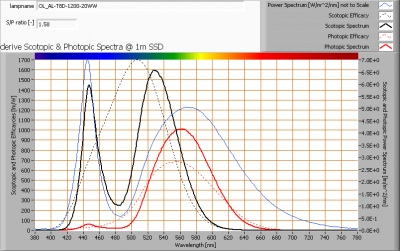
The power spectrum, sensitivity curves and resulting scotopic and photopic spectra (spectra energy content defined at 1 m distance).
The S/P ratio is 1.6.
More info on S/P ratio can be found on the OliNo website.
Chromaticity diagram
The chromaticity space and the position of the lamp’s color coordinates in it.
The light coming from this lamp is inside the area of class A. This is an area defined for signal lamps, see also the OliNo website.
Its coordinates are x=0.3577 and y=0.3606.
Color Rendering Index (CRI) or also Ra
Herewith the image showing the CRI as well as how well different colors are represented (rendered). The higher the number, the better the resemblance with the color when a black body radiator would have been used (the sun, or an incandescent lamp). Practical information and also some critics about the CRI can be found on the OliNo website.
Each color has an index Rx, and the first 8 indexes (R1 .. R8) are averaged to compute the Ra which is equivalent to the CRI.
CRI of the light of this lightbulb.
The value of 68 is lower than to the value 80 which is considered a minimum value for indoor usage.
Note: the chromaticity difference is 0.0005 indicates the distance to the Planckian Locus. There is no norm yet that states what the max deviation from white light is allowed to be. A reference with signal lights as a reference is given in the chromaticity diagram.
Voltage dependency
The dependency of a number of lamp parameters on the lamp voltage is determined. For this, the lamp voltage has been varied and its effect on the following light bulb parameters measured: illuminance E_v [lx], the lamppower P [W] and the luminous efficacy [Lm/W].
Lamp voltage dependencies of certain light bulb parameters, where the value at 230 V is taken as 100 %.
The illuminance and consumed power vary linearly when the voltage is varied. At the flicker measurement it becomes clear that single side rectification takes place. This saves a big capacitor and might have a positive impact on the lifetime of the driver. Such a simple driver has as a consequence that the current through the leds is dependent on the voltage over the tube.
When the voltage at 230 V varies with + and – 5 V, then the illuminance varies ≈ 4 %, so when abrupt voltage changes occur this effect is not visible in the illuminance output.
Warm up effects
After switch on of a cold lamp, the effect of heating up of the lamp is measured on illuminance E_v [lx], the lamppower P [W] and the luminous efficacy [lm/W].
Effect of warming up on different light bulb parameters. At top the 100 % level is put at begin, and at bottom at the end.
The warm up time is about 20 minutes and during that time the illuminance decreases with 8 % and the consumed power with 5 %.
Measure of flickering
An analysis is done on the measure of flickering of the light output by this light bulb. See the OliNo site for more information.
The measure of fast illuminance variation of the light of the light bulb
| parameter | value | unit |
|---|---|---|
| Flicker frequency | 100 | Hz |
| Illuminance modulation index | 100 | % |
The illuminance modulation index is computed as: (max_Ev – min_Ev) / (max_Ev + min_Ev).
Additional photo
Back side of the tube with the small alu heat sink.
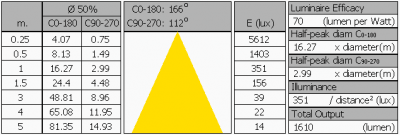
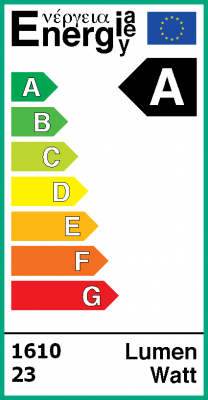

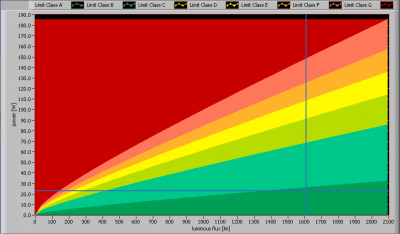
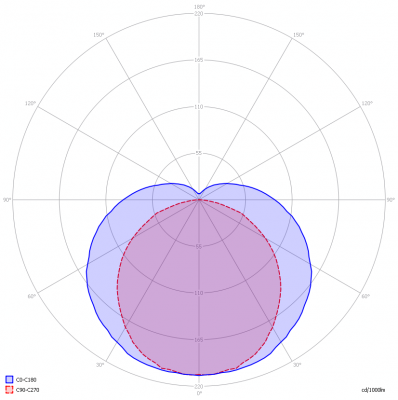
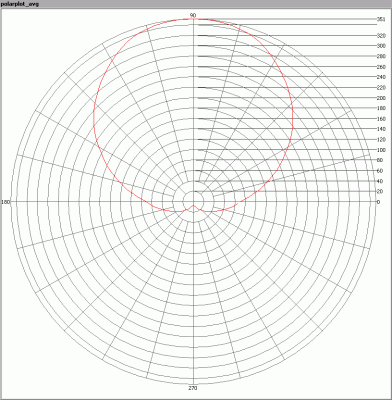
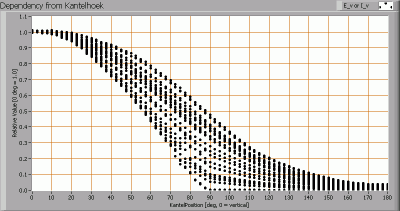
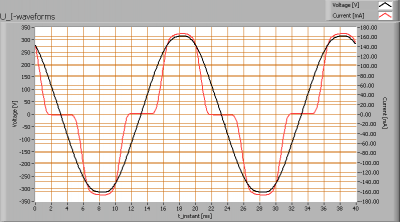
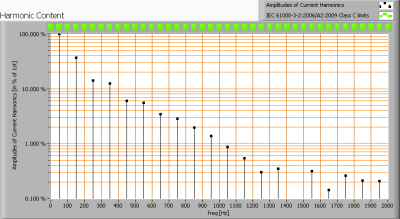
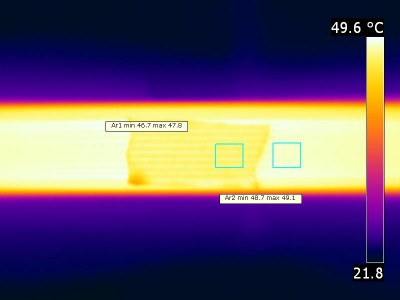
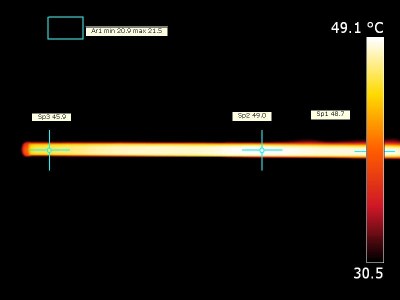
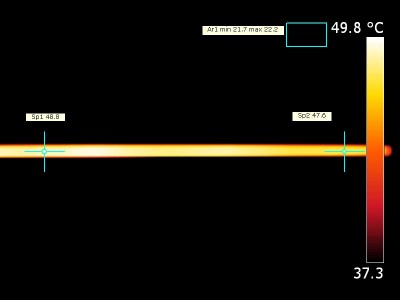
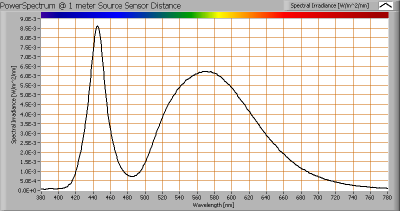
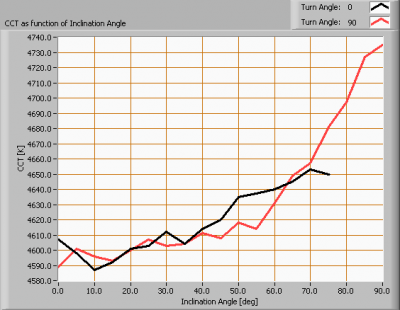
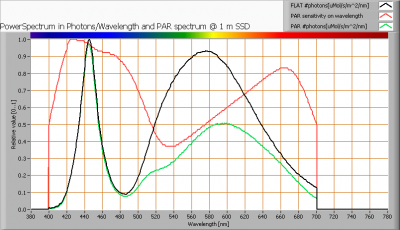
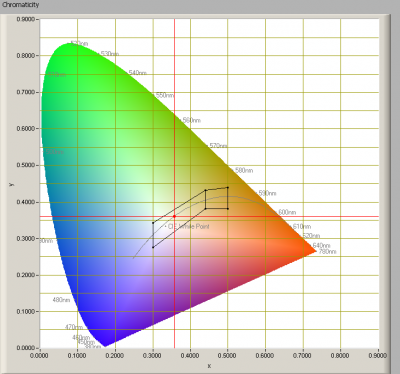
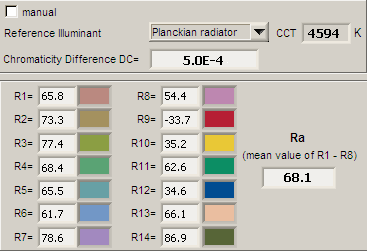
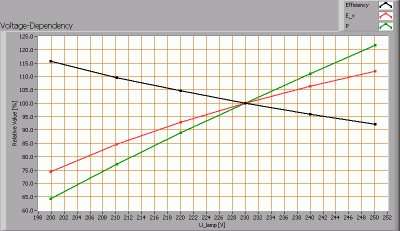
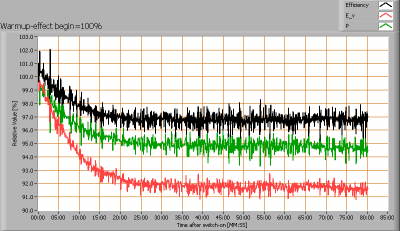
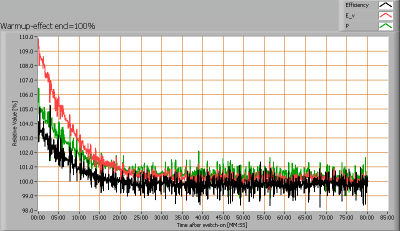
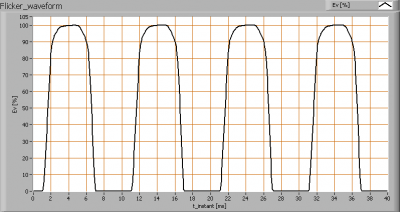
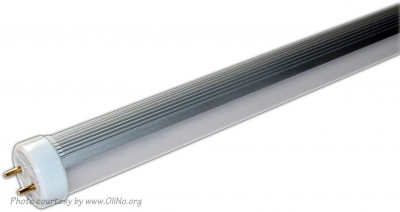



Most popular posts